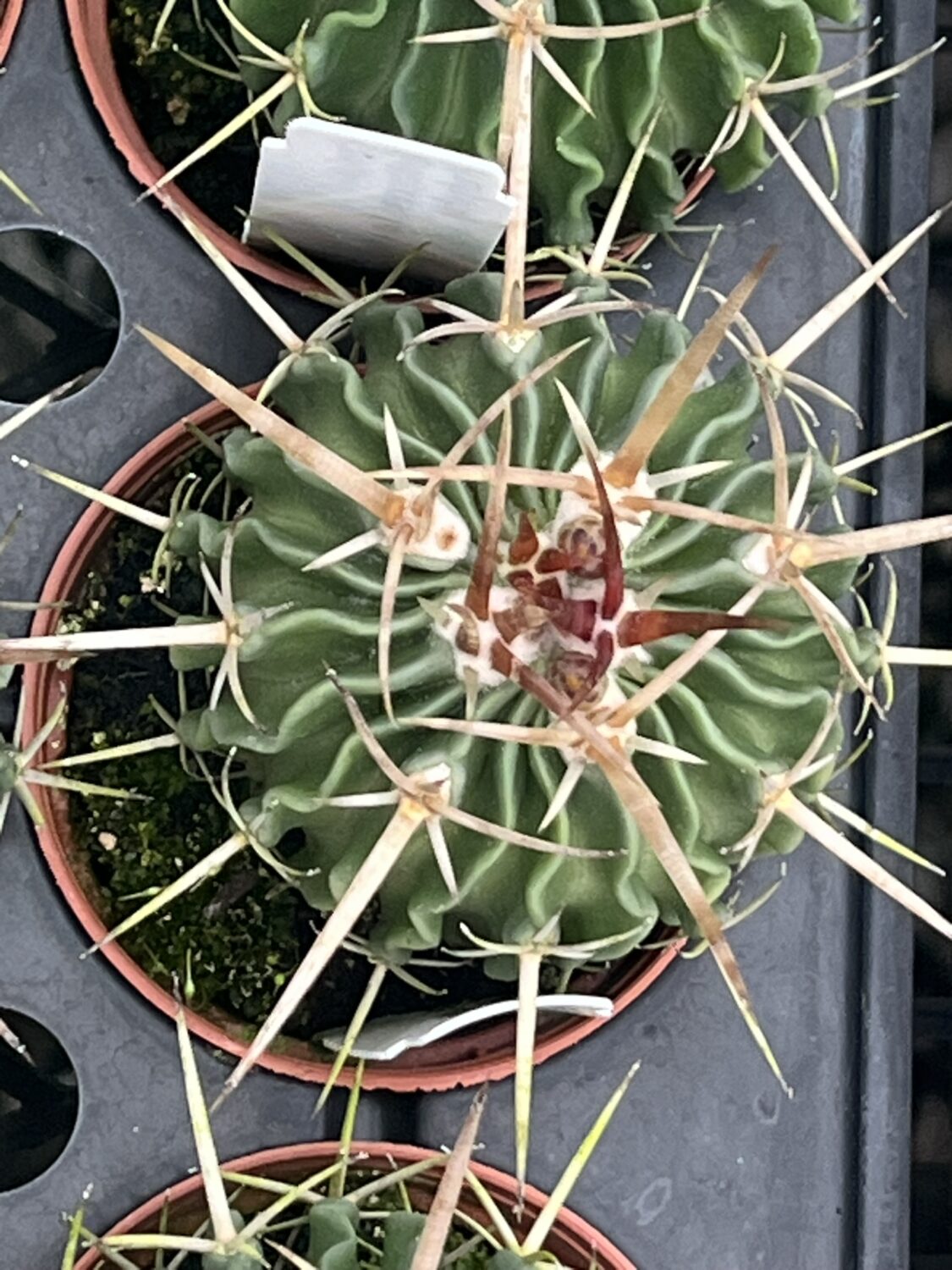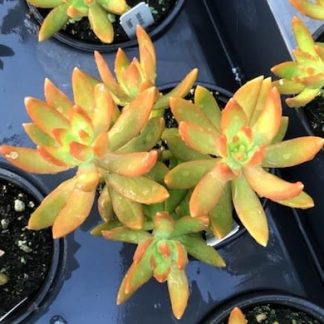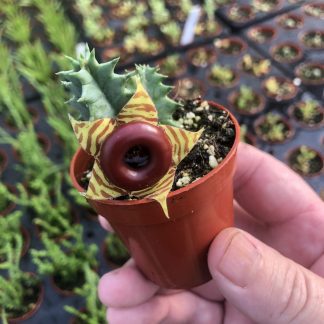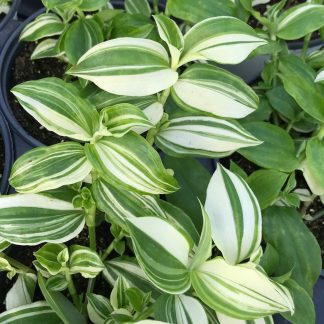Description
Stenocactus crispatus: A Unique Gem for Your Cactus Collection
Stenocactus crispatus, often called the “Brain Cactus,” is one of those plants that stops you in your tracks. Native to the dry landscapes of Mexico, this compact cactus is instantly recognizable for its mesmerizing ribs — wavy, tightly packed, and twisted in a way that resembles the folds of a brain. It’s a natural work of art, perfect for collectors or anyone seeking a standout plant for their space.
Despite its striking looks, Stenocactus crispatus isn’t difficult to grow. It’s hardy, small enough for windowsills, and rewarding when it blooms. In late spring or summer, funnel-shaped flowers appear, ranging from pure white to soft pink. These blooms are delicate and short-lived, but they create an unforgettable contrast against the cactus’s rugged body.
Whether you’re just starting a cactus collection or adding to an established one, this plant delivers charm, texture, and resilience.
What Makes Stenocactus Crispatus Special?
Compact and Manageable
This cactus usually grows 4–6 inches tall and about 3–5 inches wide. Its modest size makes it ideal for small spaces, containers, or as part of a mixed cactus display.
Architectural Beauty
Its 30–40 undulating ribs give it a sculptural quality. Each rib is lined with spines that range from creamy white to deep brown, adding even more visual interest.
Seasonal Blooms
Though small — often just an inch across — the flowers add a surprising burst of color in late spring or early summer. They’re typically pale pink or white, bringing a soft touch to the cactus’s rugged form.
Resilient Nature
Adapted to arid and semi-arid conditions, Stenocactus crispatus thrives with minimal care. It’s naturally drought-tolerant and can handle a bit of neglect, which makes it beginner-friendly.
How to Grow Stenocactus Crispatus
1. Light Requirements
Bright light is key to this cactus’s health and color.
-
Indoors: Place near a south- or west-facing window for 4–6 hours of direct sunlight daily. If sunlight is limited, a grow light works well.
-
Outdoors: Choose a full-sun spot with some afternoon shade in very hot regions to prevent scorching.
2. Temperature and Humidity
This desert native thrives in warmth and dryness.
-
Ideal temperatures are 65°F–80°F (18°C–27°C).
-
It tolerates brief drops to 40°F (4°C) but must be protected from frost.
-
Avoid high humidity, which can lead to rot. Ensure good airflow around the plant.
3. Soil Mix
Drainage is critical. A gritty, airy soil mix mimics its natural habitat and prevents root rot.
Try this simple blend:
-
2 parts coarse sand or perlite
-
1 part potting soil
-
1 part pumice or fine gravel
Use a pot with drainage holes for best results.
4. Watering
Overwatering is the most common mistake.
-
In spring and summer: Water deeply, then allow soil to dry completely before watering again.
-
In fall and winter: Water sparingly — as little as once every 4–6 weeks. The plant rests during this period and needs minimal moisture.
-
Always test the soil’s dryness with your finger or a moisture meter before watering.
5. Fertilization
Feeding helps maintain growth and encourage blooms.
-
Use a diluted cactus fertilizer (like 10-10-10) once a month during the growing season.
-
Stop feeding during winter dormancy.
6. Potting and Repotting
-
Select a pot slightly larger than the root ball, but don’t oversize — extra soil holds water and can lead to rot.
-
Repot every 2–3 years in early spring.
-
Handle carefully; wear gloves or use tongs to avoid spines.
Caring for Stenocactus Crispatus
Pest Management
This cactus is fairly pest-resistant, but check occasionally for:
-
Mealybugs: White, cottony spots. Remove with rubbing alcohol on a cotton swab.
-
Spider mites: Fine webbing and yellowing patches. Treat with neem oil or horticultural spray.
Early action prevents infestations from spreading.
Pruning and Maintenance
Minimal pruning is needed. Remove:
-
Dead or shriveled spines
-
Spent flowers
Use clean tools to avoid damaging the plant.
Encouraging Blooms
To boost flowering:
-
Provide ample sunlight during active growth.
-
Allow winter dormancy with reduced watering and cooler conditions.
-
Add a phosphorus-rich fertilizer in early spring to encourage buds.
Seasonal Care
-
Spring/Summer: Active growth — focus on light, water, and feeding.
-
Fall/Winter: Resting period — reduce watering, keep cooler but bright.
Propagation
By Seeds
-
Sow seeds in a shallow tray of cactus mix.
-
Lightly cover, mist, and keep warm and bright.
-
Germination takes about 2–4 weeks.
By Offsets
-
Some plants form offsets at the base.
-
Gently remove them during repotting.
-
Let cut ends callus for several days before planting to prevent rot.
Troubleshooting Common Problems
-
Overwatering: Causes yellowing or mushy stems. Let soil dry and adjust watering.
-
Sunburn: White or brown spots from too much direct sun. Move to filtered light.
-
Root Rot: If the cactus becomes unstable, check roots, cut away rot, and repot in fresh, dry soil.
Why Add Stenocactus Crispatus to Your Collection?
This cactus isn’t just another green ball with spines. It’s a conversation piece — a living sculpture that blends rugged beauty with surprising delicacy. Its small size fits into any collection, from minimalist windowsills to elaborate desert gardens.
Best of all, caring for it connects you to the quiet resilience of desert life. Every rib, every spine, and every rare bloom reminds us of nature’s ability to thrive in the harshest places.
A Living Sculpture Worth Savoring
Stenocactus crispatus offers something rare: personality in a plant. With its brain-like ribs, subtle flowers, and forgiving nature, it’s both fascinating and approachable. Whether you’re a first-time cactus owner or a seasoned collector, this plant rewards your attention — and asks for very little in return.
Bring one home, give it a sunny spot, and watch it transform from a small curiosity into the quiet star of your collection.




